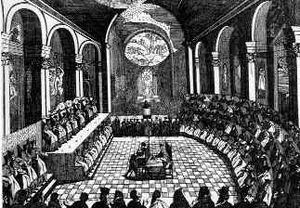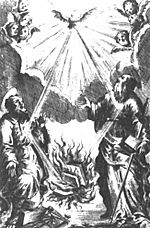Counter-Reformation facts for kids
The Counter-Reformation was a big movement within the Catholic Church. It aimed to make the Church better and stronger. This movement started because of the Protestant Reformation, which had led to the creation of many new Protestant churches.
The Counter-Reformation began around 1545 with an important meeting called the Council of Trent. It mostly ended in 1648, after a series of conflicts known as the European wars of religion.
Contents
What Was the Counter-Reformation?
After Martin Luther's actions led to the Protestant Reformation, the Catholic Church reacted in two main ways. First, they worked harder to spread their faith. Second, they strongly defended parts of their faith that Protestants had questioned. For example, they reinforced the importance of the seven sacraments and their belief in transubstantiation (the belief that bread and wine truly become the body and blood of Christ).
This period focused on several key areas:
- Beliefs: Strengthening Catholic teachings.
- Church Structure: Reorganizing how the Church was run.
- Religious Groups: Creating or reforming religious orders like the Jesuits.
- Spiritual Life: Encouraging deeper personal faith.
- Politics: Dealing with political challenges related to religion.
Important Events and Changes
Many important things happened during the Counter-Reformation. Here are some of them:
- The Council of Trent met from 1545 to 1563 to discuss Church reforms.
- In 1570, Pope Pius V made the Tridentine Mass the standard way to celebrate Mass.
- The Battle of Lepanto took place in 1571, a major naval victory for Catholic forces.
- Under Pope Gregory XIII (1572–1585), the Gregorian calendar was adopted, which we still use today. He also helped found the Pontifical Gregorian University and built an observatory.
- The Jesuit China mission began with Matteo Ricci, who traveled to China.
- There were also conflicts like the French Wars of Religion and the final parts of the Thirty Years' War (1618–1648).
- A famous scientist, Galileo Galilei, was part of the Lyncean Academy in the Papal States, though he later faced a trial for his scientific views.
The Council of Trent

Pope Paul III (1534–1549) is often seen as the first pope of the Counter-Reformation. He started the Council of Trent to fix problems within the Catholic Church.
During the council, several key decisions were made:
- It was decided that the Mass should be standardized. This led to the Tridentine Mass becoming mandatory in 1570.
- The council firmly rejected any compromises with Protestants.
- It clearly restated the main beliefs of the Catholic Church.
- It reaffirmed the traditional foundations of the Church.
At the same time, the council also brought about important changes. For example, it was decided that parish priests should receive better education and learn Latin. The Council of Trent worked to improve the discipline and management of the Church. Bishops were no longer appointed just for political reasons.
The council also gave bishops more power to oversee religious life. Dedicated leaders, like Archbishop Carlo Borromeo of Milan, visited even the most distant parishes to ensure high standards.
Baroque Art and the Church
The Catholic Church was a major supporter of art throughout Europe. A big goal of art during the Counter-Reformation was to show the strength and importance of Catholicism. This led to the development of the Baroque art style in the late 1500s.
The Council of Trent stated that architecture, painting, and sculpture were important for sharing Catholic ideas about God. Depicting Christ's suffering was seen as good and proper. While some Protestant reformers were removing images from churches, Catholic reformers emphasized the value of art. They especially encouraged creating images of the Virgin Mary.
Related pages
Images for kids
-
A copy of the Sixtine Vulgate, the Latin edition of the Catholic Bible printed in 1590 after many of the Council of Trent's reforms had begun to take place in Catholic worship
See also
 In Spanish: Contrarreforma para niños
In Spanish: Contrarreforma para niños




